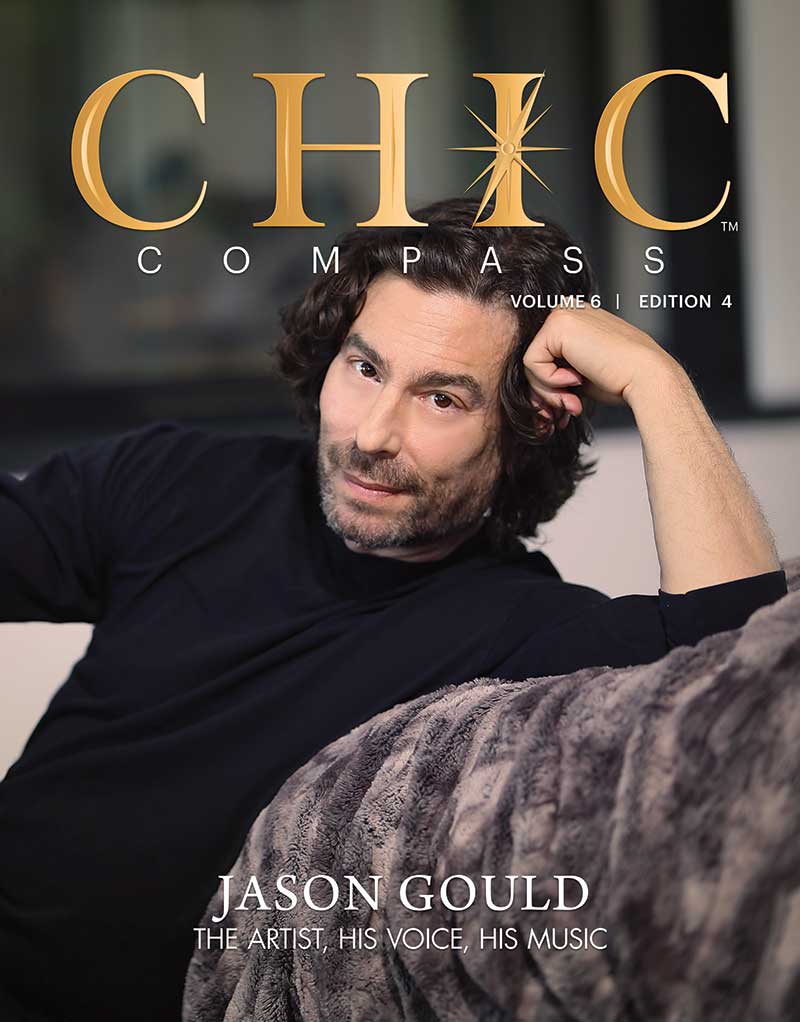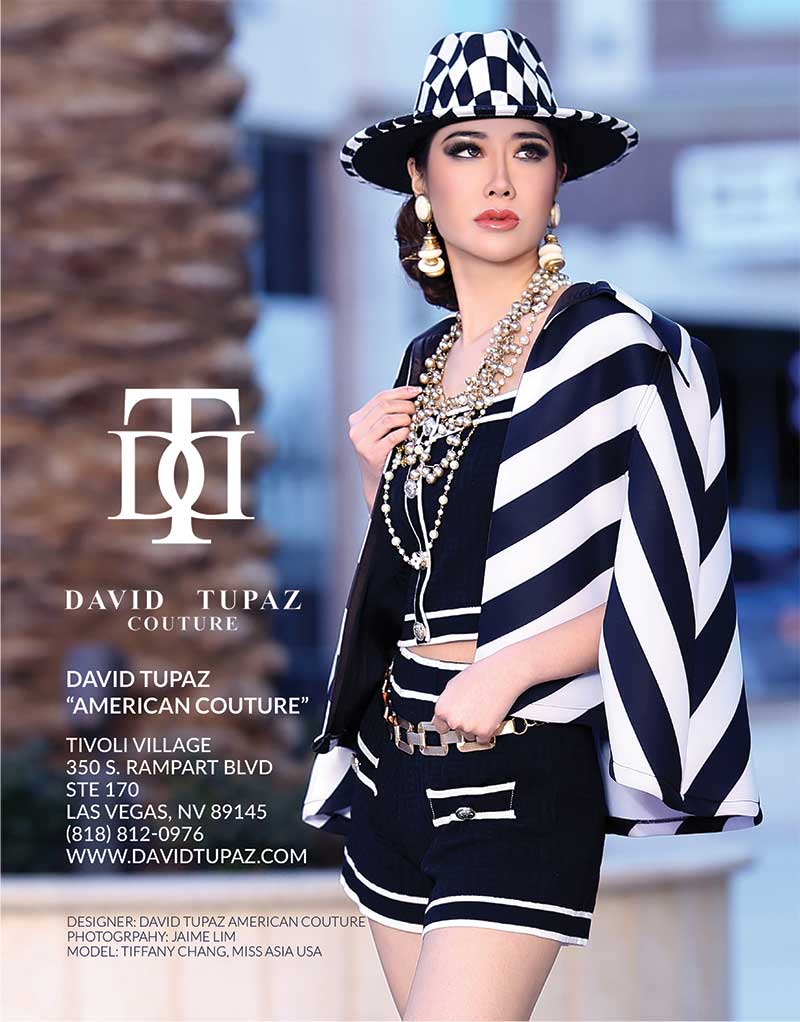Major League Throw Down of Breaking Hits Vegas
By Kendall Hardin
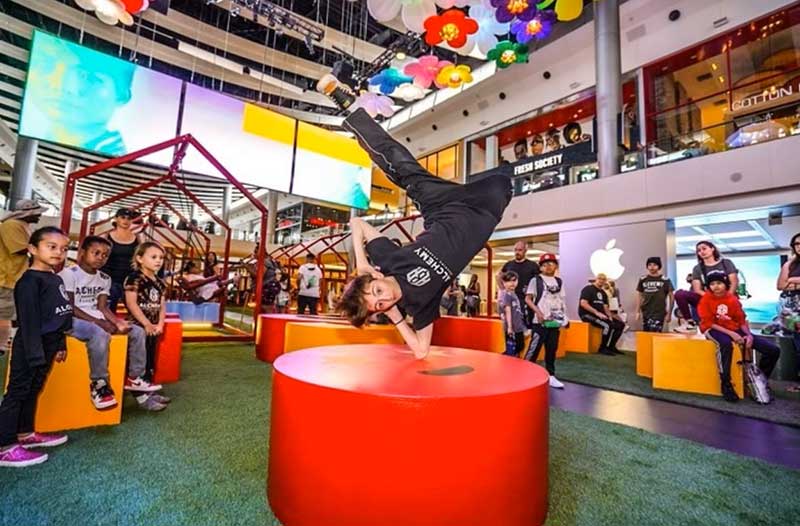
ABA breakers put on a show at the Fashion Show Mall. Photo courtesy of Fashion Show
Could breakdancing — the newest sport of the 2024 Olympics – become the coolest and hottest addition to world-class sports in Las Vegas?
As two world champion B-boy brothers, Etienne and Guillaume Carreira, forge the breaking scene in Las Vegas, the city is well on its way to becoming the international epicenter of this trailblazing sport and art form.
Breakdancing, more commonly called breaking, B-boying or B-girling – and growing out of the hip-hop movement – is a style of street dance that is hyper-athletic, skill-powered and improvisational. “It’s as if dance and gymnastics had a baby,” one breaking fan explained.
Breaking as a sport evolved out of five core movements: Top Rock (stand-up dancing), Down Rock (dancing on the floor), Fast Footwork, Power Moves (spins, tricks, flips) and Freezes (acrobatic poses) – all while gyrating to the DJ’s musical drumbeat.
Judges score each breakdancing “battle” on five criteria: technique, vocabulary, execution, musicality and originality. With its official Olympic splash in Paris this past June, breakdancing has exploded into a legitimate art form, professional sport and a novel entertainment platform with its own fan base.
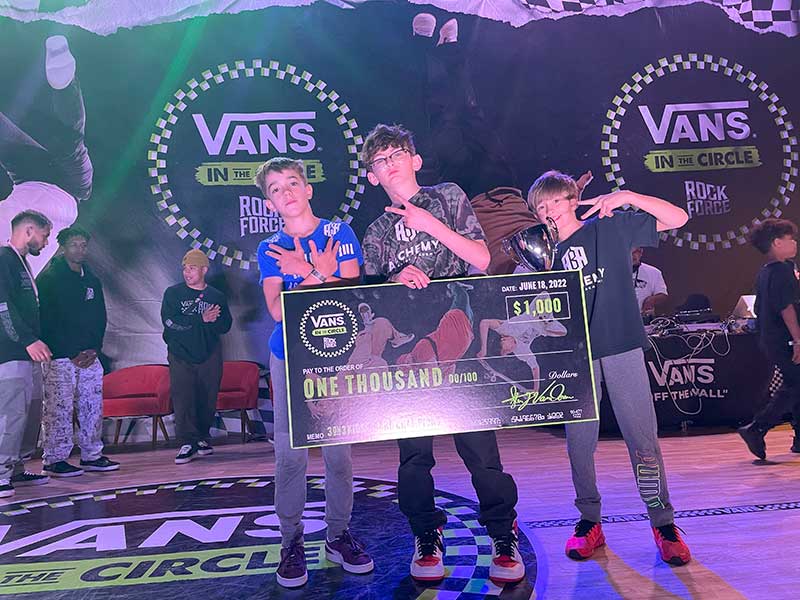
Alchemy team celebrates its first top place prize at In The Circle (ITC) competition. Photo courtesy of ABA
Training a New Wave of Breakers
The path to professional breakdancing was an ideal, if not destined, transformation for Etienne and Guillaume. As sons of two professional dance gypsies, the boys followed their parents’ show biz journey to major cities in Hawaii and on the mainland, finally landing in Las Vegas in 1997.
“We came late to dance as teens when our mother ‘tricked’ us into joining class, promising that we’d meet lots of girls. And she was right!” recalled Etienne with a grin. “We worked on the Strip even while I was in high school at the Las Vegas Academy and Guillaume was at Chaparral High School, at a time when breakdancing was permeating American youth culture.”
The brothers officially opened the Alchemy Breaking Academy in the summer of 2019 in sublet venues. Still, student demand forced them to launch their own studio in a modern warehouse development in central Las Vegas two years later. The business, totally funded by tuition, has continued to flourish.
“Our sweet spot is training younger kids,” explained Guillaume. “We offer beginner, intermediate and advanced classes, with advancement by skill level rather than age.” The brothers teach foundational skills from the ground up, focusing on strength-building, tumbling/acrobatics and basic dance moves set to music.
“We mitigate risks however we can with a lot of mat work,” added Etienne. “But the little ones are fearless – they catch on fast.” The Academy’s after-school and evening classes also include two competitive youth teams (or crews in breaker terms) organized by performance level, as well as master classes and competition coaching.
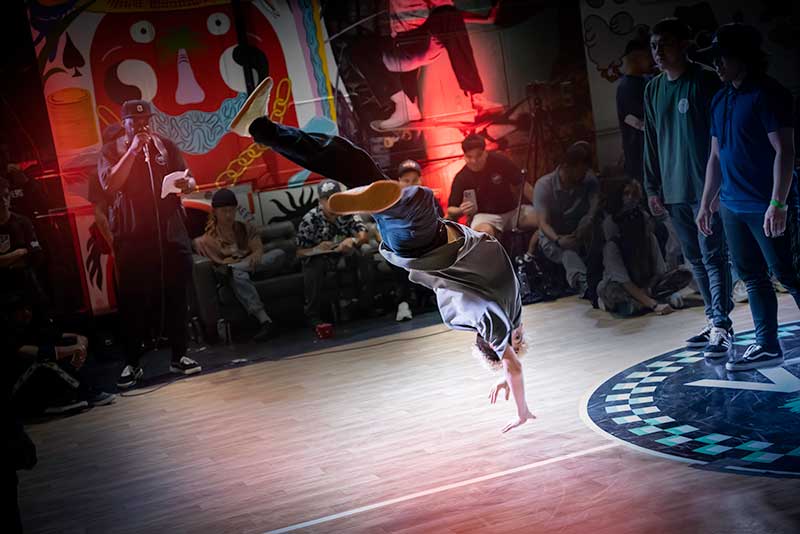
B-boy Lineage, aka Robes Carreira, airborne at In The Circle (ITC) competition. Photo by Elisa Terry Art & Photography
Major League Breaking on the Home Front?
Just two weeks after breakdancing’s Olympic debut, the Carreira brothers designed, produced and launched the country’s first Elite Breaking League event at the 4500-seat theater at Virgin Hotels Las Vegas, challenging eight of the world’s best breakdancers (including American B-boy Victor Montalvo, this year’s Olympic bronze winner) to a judged “dance-off” competition, with the winner receiving $10,000 and the first EBL Championship Ring.
“We’d been thinking about it over the last five years,” mused Etienne. “There’s nothing like it in the United States. We want to create a major league for professional breakers with an annual ‘season’ – just like the NFL or NBA – right here in Las Vegas.”
“Our goal is to elevate breakdancing,” chimed in Guillaume. “We need to create an extraordinary experience and develop a huge fan base for breaking at its highest level.”
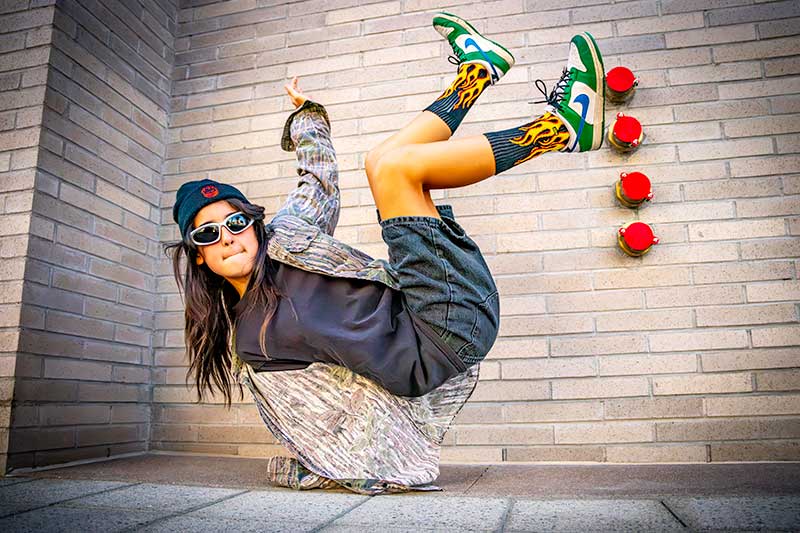
B-girl ElleBoogie, aka Elle Del Pozo, models flame socks by Pivot Apparel. Photo by Elisa Terry Art & Photography
The Elite Breaking League’s Vegas Vision
The brothers are hard at work establishing the League’s roll-out for 2025, exploring multiple venues to lock down the ideal fit and pursuing sponsorships that align with breaking as a sport in the future. “We’re looking at a seven-month season, culminating in a final competition in August that showcases the top athletes who qualify for the 2025 title,” explained Etienne.
Why not bring the best and brightest breakers in the world to Las Vegas to vie at the highest level of elite professional competition?
And where better to establish this new hybrid art form/sports model than in the Entertainment Capital of the World, which is fast becoming the country’s hip professional sports mecca?
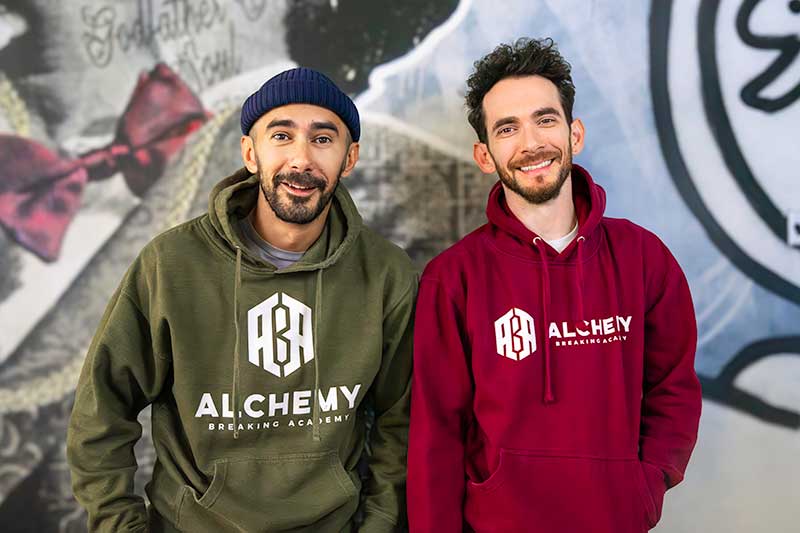
Alchemy’s Coaches: Brothers Guillaume and Etienne Carreira – professional dancers and B-boys for well over two decades – have performed with Cirque du Soleil, The Jabbawockees, STOMP, Usher, Jennifer Lopez and others. Having competed and performed in 63 countries, they passionately share their experience and knowledge with the next generation. Photo by Elisa Terry Art & Photography
The Benefits of Breaking by Etienne Carriera
Guillaume and I have been teaching in the dance world for decades, but for the last five years, we’ve focused specifically on teaching breaking. The vast majority of our students are under 10 years old. I’ve seen kids come into their first class shy and introverted, almost embarrassed to try anything. With consistent attendance at our breaking classes, they transform into confident young individuals in just two to three months. I’ve witnessed this metamorphosis countless times over the past five years.
Breaking offers numerous benefits for self-development, physical growth and social skills. It fosters strong community bonds that last a lifetime. Not only do you get the benefits of physical exercise, but you also experience the therapeutic power of music. This dance provides an outlet for trauma, hardship and emotional turmoil, making it a powerful tool for turning negatives into positives.
That’s how breaking started in NYC in the 1970s. It was born out of necessity and continues to uplift communities today. Breaking also brings people from all walks of life together. Guillaume and I have been fortunate enough to travel the world and compete at the highest levels. We’ve shared cyphers with people from different countries, where we couldn’t communicate through words—but through dance, we understood each other perfectly.
Breaking is a universal language that helps us focus on our commonalities rather than our differences. It unites people; if you ask me, it’s exactly what the world needs right now.

For more information about Alchemy Breaking Academy, visit www.alchemybreaking.com.
For videos of breaking at the 2024 Paris Olympics, visit www.nbcolympics.com/videos/olympics-101-breaking-paris-2024.
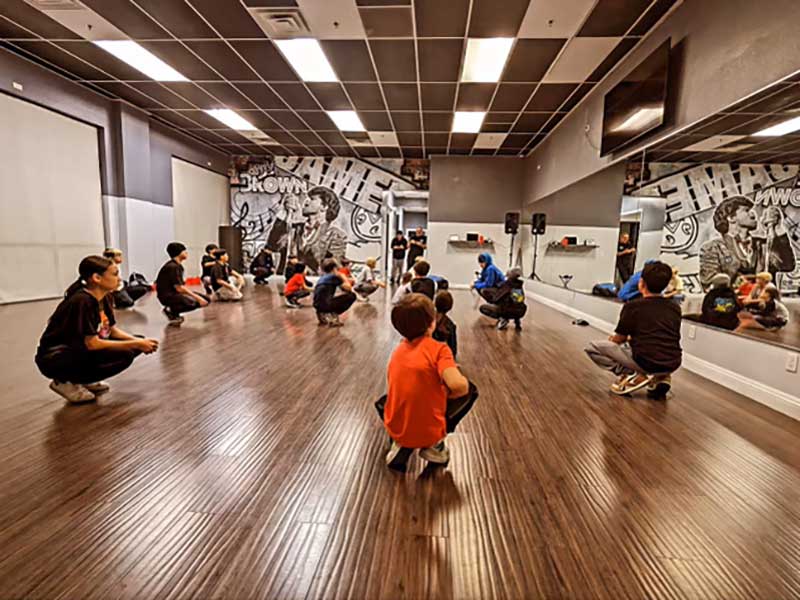
Young breakers in the studio at Alchemy Breaking Academy (ABA). Photo courtesy of ABA
Lingo for B-Fans
1990: Spin on one’s hands while in a handstand position
B-boy or B-girl: A break boy/break girl; a breakdancer
Backflip: Dancer flips over backwards
Backspin: Dancer balances weight on the upper back and goes into a spin by pushing with the hands or swinging the legs across the body
Battle: A breaking competition that can be individual or groups (crews)
Downrock: Dance moves on the floor
Flare: Power move done on hands, adopted from pommel horse gymnastics
Footwork: Sporadic moves, kicks, pivots and spins on the floor
Freeze: Stopping a dance and holding a position, often balancing on one’s shoulder, head or hands
Fresh: Descriptive term for anything good – the opposite of “wack”
Frontflip: A flip in the direction dancer is facing
Halo: Windmill variation spinning around the crown of one’s head
Hand Spin/Glide: Dancer spins on one hand with the body parallel to the ground
Headspin: In a headstand position, dancer spins by pushing with the hands
Power Moves: Spins, tricks and flips that require body momentum
Top Rock: Dance done standing before hitting the floor
Turtle: Dancer spins with hands on the ground and legs in the air
Wack: Term that refers to anything bad, usually a move done incorrectly; the opposite of “fresh”
Windmill: Dancer rotates continuously on one shoulder with feet in the air and legs apart
Breaking Competitive Terms
Bite/biter/biting: When a breaker is accused of “biting” or being a “biter,” it means that they have either stolen or copied moves/style from another breaker. Similar to “repeating,” this can also affect a breaker’s originality score.
Crashing: If a breaker “crashes,” it means they failed an attempted move and fell during or at the end of their attempt. This may be the most common cause of a breaker losing a battle. The best breakers, however, know how to turn a crash into a move and can control the crash enough to continue their flow into something else.
Crew: A group of breakers who train and compete together. Historically, rival crews have often competed against each other under various sets of rules.
Repeating: When a breaker reuses a move, they’ve already made during the competition, they are considered “repeating.” Originality accounts for 20% of a breaker’s score. Repeating can negatively impact that score.
Set: A set is a breaker’s prepared round or combination of moves.
Throw down: When the B-girl or B-boy hits the floor and starts breaking, they’re doing a throw down.

